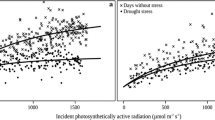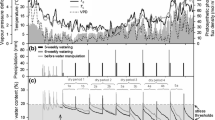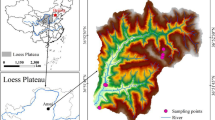Abstract
A field experiment primarily designed for simulating the indirect effects of air pollutants for a 25-year-old Norway spruce stand in SW Sweden is presented (The Skogaby project). Treatment include irrigation; artificial drought; ammonium sulphate addition; nitrogen-free-fertilization and irrigation with liquid fertilizers including a complete set of nutrients. The experiment has a randomized block design with four replicates per treatment. Growth response on an areal basis of basal area, height and dry mass of stems, branches and needles after up to four years of treatment are presented. Dry mass is estimated using allometric equations based on destructive samplings of trees.
The stand suffered from temporary water stress during all four years investigated despite 970– 1160 mm of annual precipitation. Irrigation resulted in improved above-ground dry mass production (stem, bark, branches, needles, litter fall) by 20% during the first 3 years of treatment, whereas 2 years of drought treatment followed by 1 year of recovery led to 10% reduced dry mass growth. During year 2 of recovery, however, basal area growth was only about half of that of the control.
Nitrogen, markedly, was a growth limiting nutrient, although the stand got approx. 20 kg N ha-1 y-1 from deposition. Ammonium sulphate addition (100 kg N ha-1 y-1) resulted in 31% improved dry mass production whereas irrigation with liquid fertilization (100 kg N ha-1 y-1) including all important nutrient elements led to 57% increased dry mass growth after 3 years of treatment. Basal area growth of the latter treatment gradually increased and during year 4 of treatment was 123% larger than the control. Nitrogen-free-fertilization resulted in a small improvement of dry mass production (+10%).
After 3 years of treatment, the amount of needles had increased markedly for both treatments including irrigation, whereas drought treated trees instead had decreased their needle amount vs control. The increase in needle amount occurred as a result of both larger formation of needles and higher preservence of old needles, the opposite relations being found for the drought treated trees. At the same point larger needle formation in combination with a higher shedding of older needles was found for trees treated with ammonium sulphate and nitrogen-free-fertilizer.
It is concluded that there is no stage of N saturation in the Skogaby site as there is no leaching of N from the control plots and N fertilization results in both increased tree growth and N uptake.
Similar content being viewed by others
References
Andersson F 1990 A field experimental approach to understanding of forest damage. In Verification of Hypotheses on the Mechanisms of Damage and Possibilities of Recovery of Forest Ecosystems. Eds. E Klimo and J. Materna. pp 157–166. International workshop, Brno 4–8 September 1989.
Baskerville G L 1972 Use of logarithmic regression in the estimation of plant biomass. Can. J. For. Res. 2, 49–53.
Bergkvist B and Folkesson L 1992. Soil acidification and element fluxes of a Fagus sylvatica forest as influenced by simulated nitrogen deposition. Water, Air, Soil Pollut. 61 (In press).
Falkengren-Grerup U 1986 Soil acidification and vegetation changes in deciduous forest in southern Sweden. Oecologia 70, 339–347.
Falkengren-Grerup U 1987 Long-term changes in pH of forest soils in southern Sweden. Environ. Pollut. 43, 79–90.
Hallbäcken L and Tamm C O 1986 Changes in soil acidity from 1927 to 1982–1984 in a forest area of south-west Sweden. Scand. J. For. Res. 1, 219–232.
Holstener-Jörgensen H. and Holmsgaard E. 1989. Vanding I skovbruket. (Irrigation in forestry). Statens Forstlige Forsögsvaesen Danmark. 5, 216–217. (In Danish).
Hüttl R F 1990 Nutrient supply and fertilizer experiments in view of N saturation. Plant and Soil 128, 45–58.
Hyink D M and Zedaker S M 1987 Stand dynamics and the evaluation of forest decline. Tree Physiol. 3, 17–20.
Ingestad T 1979 Mineral nutrient requirements in Pinus sylvestris and Picea abies seedlings. Physiol. Plant. 45, 373–380.
Jacks G, Andersson S and Stegman B 1989 pH changes in forested and open land in Sweden. In Ecological Impact of Acidification. Ed., Szabolcs. pp. 103–104. Proceedings of the joint symposium Environmental Threats to Forest and Other Ecosystems, Oulo, Finaland, 1988.
Jansson P-E, Ed. 1990 Air pollution, tree vitality, forest damage and production. The Skogaby Project. Dept. Soil Sciences, Swed Univ Agric Sci. Avdelningsmeddelande 90, 2. 80 p.
Johnson A H and Siccama T G 1983 Acid deposition and forest decline. Environ. Sci Technol. 17, 294A-305A.
Johnson D W, Cresser M S, Nilsson S I, Turner J, Ulrich B, Binkley D and Cole D W 1991 Soil changes in forest ecosystems: Evidence for and probable causes. International Conference on Acid Deposition: Its Nature and Impacts, Glasgow, 1990. Proceedings of the Royal Society of Edinburgh, 97B, 81–116, 1991.
Lindroth A 1989 Water status of the forest—a stress factor worth considering. Skogsfakta 12, 54–59. (In Swedish).
Marklund L G 1987 Biomass functions for Norway spruce (Picea abies (L.) Karst) in Sweden. Dept. For. Survey, Swed Univ Agric Sci, Rep 43. 127 p.
Mead D J and Tamm C O 1988 Growth and stem form changes in Picea abies as affected by stand nutrition. Scand. J. For. Res. 3, 505–513.
Möller G 1986 Results from forest fertilization trials in areas with high nitrogen input. In Nitrogen Saturation, abstracts from a workshop. National Swedish Environmental Protection Board. Report 3153, pp 49–61.
Monteith J L 1965 Evaporation and environment. In The State and Movement of Water in Living Organisms. Symp. Soc. Exp. Biol. 19, 205–224.
Nihlg»rd B 1985 The ammonium hypothesis—an additional explanation to the forest dieback in Europe. AMBIO 14, 2–8.
Nilsson L O 1990 Tree growth, above-ground budgets for nutrients and biomass In Air Polution, Tree Vitality, Forest Damage and Production. The Skogaby Project. Ed. P-E Jansson. pp 13–18 Dept. Soil Sciences, Swed Univ Agric Sci, Avdelningsmeddelande 90, 2.
Nilsson L O 1991 Investigation of impact of air pollution on tree vitality, forest damage and forest production. The Skogaby Project. Biomass performance after three years of treatment. IUFRO and ICP-forest workshop on Monitoning Air Pollution Impact on Permanent Sample Plots, Data Processing and Results Interpretation. Prachatice, Czechoslovakia, 2–6 September 1991, 238 p.
Puhe J Persson H and Börjesson I 1986 Wurzelwachstum und Wurzelschäden in skandinavischen Nadelwäldern. AFZ 20, 488–492. (In German).
SAS Institute Inc. 1989 SAS/STAT User's Guide: Basics, Version 6, Fourth Edition, Volume 2. SAS Institute INC, Cary, NC. 846 p.
Tamm C O 1979 Nutrient cycling and productivity of forest ecosystems. In Impact of Intensive Harvesting on Forest Nutrient Cycling. Ed A LLeaf. pp 2–21. Proceedings. State Univ. New York Coll. Environ. Sci. and Forestry, Syracuse, NY.
Tamm C O and Hallbäcken L 1988. Changes in soil acidity in two forest areas with different acid deposition: 1920s to 1980s. AMBIO 17, 56–61.
Tyler G Balsberg-Påhlsson A-M Bergquist B Falkengren-Grerup U Folkeson L Nihlgård B Rühling Å and Stjernquist I 1992 Chemical and biological effects of artificially increased nitrogen deposition to the ground in a Swedish beech forest. Scand. J. For. Res. 7 (In press).
Waring R H 1985 Imbalanced forest ecosystems: Assessments and consequences. For. Ecol. Manage 12, 93–112.
Waring R H and Schlesinger W H 1985 Forest Ecosystems Concepts and Management. Academic Press. 340 p.
Whittaker R H and Marks P L 1975 Methods of assessing terrestrial productivity. In Primary Productivity of the Biosphere. Eds. HLieth and R HWhittaker. pp 55–118. Springer-Verlag, New York.
Author information
Authors and Affiliations
Rights and permissions
About this article
Cite this article
Nilsson, LO., Wiklund, K. Influence of nutrient and water stress on Norway spruce production in south Sweden — the role of air pollutants. Plant Soil 147, 251–265 (1992). https://doi.org/10.1007/BF00029077
Received:
Issue Date:
DOI: https://doi.org/10.1007/BF00029077




